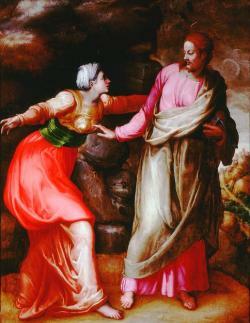Mannerism is considered a period of European arts. The frame of this period is considered to be from the later years of the High Renaissance up to the Baroque came into place. It took a period from 1520 up to the time around 1600. The base of this style lies in the diversity of personal views that appeared under the effect and are associated with Da Vinci, Raphael, Michelangelo. Mannerism is different from other styles because of some of its synthetic and also for its intellectual properties. The term is also useful to describe some Late Gothic painters, that worked in northern Europe from about 1500 to 1530.
The early Mannerists are commonly set in absolute contrast to High Renaissance conventions; the closeness and balance achieved by Raphael’s School of Athens, no longer seemed applicable or suitable. Mannerism developed among the pupils of two masters of the classical approach, with Raphael’s assistant Giulio Romano and among the students of Andrea del Sarto. Michelangelo displayed tendencies towards Mannerism, it is also notable in his entrance hall to the Laurentian Library and the figures on his Medici tombs. Mannerist centers in Italy were Rome, Florence, and Mantua. Paintings from Venice are presented as separate “schools”. Venice took a different course with a change in this style, which appears in the works and the whole career of Titian.
A good example of a mannerism work was painted by Giovanni-Battista Franco in the 16th century. (Giovanni-Battista Franco (born in 1510 – died in 1561) I Italian painter). There is a vast number of artworks, showing the meeting of Magdalena with Jesus after his resurrection. By comparing this piece of art, with others reproducing the same scene, it is easy to make conclusions about mannerism in general.

The majority of people, who saw the picture, consider it to be pretty strange. But together with the fact that it is visually disturbing, it is a perfect case of the sixteenth-century Mannerist. The actual work, its composition, is taken in a lot of its details from a study made by the Renaissance master Michelangelo. But in this painting, even Michelangelo’s monumental style has become overwhelmingly exaggerated. The figures are lofty and awkward; their proportions are not in fact at all possible. There are no distinctive main colors of the Renaissance: the normal yellow, blue and red that are expected to be found in a Renaissance work of art. Here in this late Renaissance work, you find harsh oranges, weird pinks, and pistachio greens. The space in the painting is either pushing out towards the viewer or moving back radically into the surrounding as at the far right. Nothing is balanced or in harmony. Even the people shown in the picture look as if they are at any minute could fall. By the late Renaissance people have gotten a little tired of all this harmony and balance and they want something new, they want something bizarre. This painting is a good example of what became a result of an evolution of the classical Renaissance. The painter wanted to show the actual mood of Christ and showed what felt Maria Magdalena using not even her face, but her body. I liked the painting because it’s a good example of how feelings may be easily transferred from some sort of a substance of energy to a real object, in this case, painting.
References
Weurtenberger, Franzsepp. “Mannerism: The European Style of the Sixteenth Century”. Trans. Michael Heron. 1st ed. New York: Holt, Rinehart and Winston, 1963.